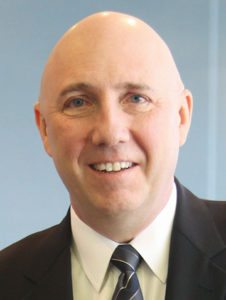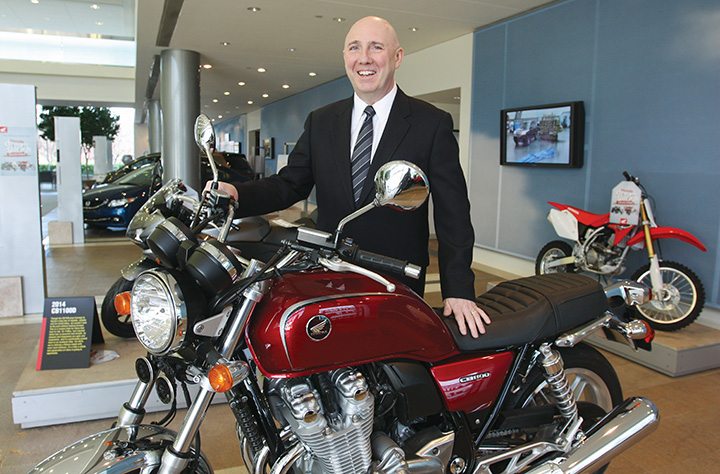2017 Industry Leader: Chuck Boderman
Chuck Boderman
Vice President, Motorcycle Division, American Honda Motor Co., Inc.
Chuck Boderman found that hiring times were difficult when he graduated from Penn State in the early 1980s with a science degree.
Alas, that Help Wanted ad in the Philadelphia Enquirer from Honda seeking a customer relations rep sounded awfully intriguing for a guy who had first hopped aboard a QA50 as a 10-year-old in Pennsylvania.

“I still remember that first bike,” Boderman said. “I kept riding and started racing motocross, then started working at a motorcycle shop as a gofer to fuel my motocross habit. Eventually I worked at the shop on a regular basis as I went through college. I worked in a PSU grad program for a little bit after college, and there were just no jobs. I was freaking out, and my dad sat me down and said ‘What’s up?’ and I told him. He asked me if I had seen anything that I was interested in. I told him I saw an ad for a customer service rep for Honda, and working for Honda sounded so cool, but I didn’t go to college for that. He said give it a try, and if you don’t like it, you leave. Just like that. I thought OK, you’re right. And I did and never left. I have never felt bored or unchallenged at Honda.”
It’s been an ideal fit for Boderman, who has been vice president of the Powersports Division at American Honda Motor Co., Inc., since 2015. He’s also the newly elected vice chairman of the Motorcycle Industry Council, which is a long way from his introduction to the company when he was hired in 1983. The stint in customer relations was followed by rounds in field service, as a district service manager and in field sales.
A move to corporate headquarters in Torrance, California, allowed him to take on roles in sales management, marketing, dealer development and business planning, before moving into his current overall operations role.
The brand’s growth across all two-wheel and four-wheel products in the past five years has been impressive, with Honda having grown more than 20 percent during that period thanks to a product lineup that has fed market demands. In the last two years alone, models ranging from the Grom to Pioneer to Africa Twin to the CBR300 and 500 and have accelerated the brand. “Our first step with our recent models was looking at, frankly, a shift in generations,” Boderman said. “That was our first impetus — to make sure we created a good, strong two-wheel entry lineup, to grow the millennial base coming through with an affordable and appealing product. The next step in that period was the rapid growth of four-wheel, especially side-by-side. That was fueled with our decision to bring side-by-side production to [Honda of South Carolina] from Mexico, and developing our R&D capabilities in Ohio so that we’re really close to the customer for developing the side-by-sides. The third step was to invest in the development of the lineup. That really fueled this whole growth of Pioneer.”
Next up is revitalization of its flagship models, which Boderman admits have lost some momentum of the years. “We’ll have all the different lifecycles for a customer to go through,” he said. “The growth is really product driven — models, innovation with things like DCT across two-wheel and four-wheel — but the connection with that has also been our dealer base. You can have the best products in the world, but if you don’t have a dealer base that can get them in front of our customers and provide a good experience with the after-service and relationship, it doesn’t come together.”
Consistent communication with its dealers has been another leading factor.
“Having the strong product that we have now certainly doesn’t hurt, but even in times when we’re maybe not leaning forward on the product release cycle, I think the relationship is where it is with dealers because we keep in strong communication with our dealers. That’s the Honda way. The team here at American Honda, we have this balance now with a lot of veterans and we have a lot of younger people coming in. It’s just a really great balance right now. It’s re-inspired us to make sure we’re staying in touch and being very close to our dealers. Things like reinforcing our dealer surveys, how often we’re getting out to talk to dealers, making sure we’re listening and giving timely feedback — that’s where we’ve blossomed recently, which is so important. You have to work on it all the time, and sometimes we might not see eye-to-eye with our dealers, but as long as we’re looking eye-to-eye, we’re halfway there.”
Boderman points to a handful of Honda leaders as having provided him with direction and mentorship along the way. Tom Willenbring hired him back in 1983. “He embodied the Honda philosophy, and it reinforced in me when I was in the field just how important that position is.” Rod Anderson and Ray Blank, along with Japanese execs Mr. Amemiya and Mr. Iwamura also were strong role models for Boderman.
“It wasn’t always just the person, but the Honda philosophy that I looked up to, and how they carried that out,” he said. “It’s part of our culture and what we do.”
Boderman commented that the total number of Honda powersports customers in the U.S. is inching close to 19 million since 1960.
“That’s such equity that we can never lose. So many of those customers came from the boomer generation, and now it’s their children that know Honda the same way. Frankly, it’s inspiring.”
What is the biggest opportunity for the motorcycle/ATV industry, and how can the industry take advantage of it?
There are so many opportunities. How well we respond to having the right products and appeal for the millennials. Not just hardware, but software like financing and different ownership paradigms. There are items that we might sometimes question or fear as being a part of the industry, like shared vehicles or autonomous vehicles, but in so many cases that technology really creates great opportunities for our industry. Vehicle-to-vehicle communications and what’s happening over on our auto side of the business and how we’re going to be able to integrate that in the future into all vehicle communications will add another level of ability for people to avoid collisions and have safer rides. That really to me is the great opportunity for our business. Not just having the products, but really embracing these changes that are happening. They can really do well for us. We just have to make sure we’re staying strong politically and making sure we have the right intersection of what we’re able to do with the technology and what the government regulations do, with making sure that they harmonize.
What has been the biggest challenge in your current position, and how have you dealt with it?
For me, you combine all those opportunities that are out there with the rapid change in the market right now, so much connectivity between different regions of the world now with all the manufacturers, and you have rapid changes. From government regulations to border taxes to emissions compliance — you have all these things that are rapidly changing. My biggest challenge is to have the patience to make sure we’re taking the time to address all of them. The good news is that all of those items really are opportunities for us. From the Honda perspective, our strength is both regional and global collaboration, both on the motorcycle market and on the four-wheel market, that it’s really helping us be synchronized and stay ahead of the curve on these changes, both from the opportunities and from the regulations or constraints.
What’s the best advice you can give others in the motorcycle/ATV market?
Never forget we’re in the best business in the world. We’re selling things that we love and are our passion. Never lose that passion. We have to keep that within us. We also have to keep working as an industry strongly together. While there are a lot of challenges, it’s only if we work together really smart that we’re going to be able to make sure that future generations are going to have the kind of sport that we so enjoy. They may have different ways that they enjoy it, but the idea of being able to have the freedom and the fun offered by our sport, we have to make sure we can ensure that for forever. We want to be a company that society wants to exist. We need to be an industry that society wants to exist. We want powersports to add that value to our lives.”









